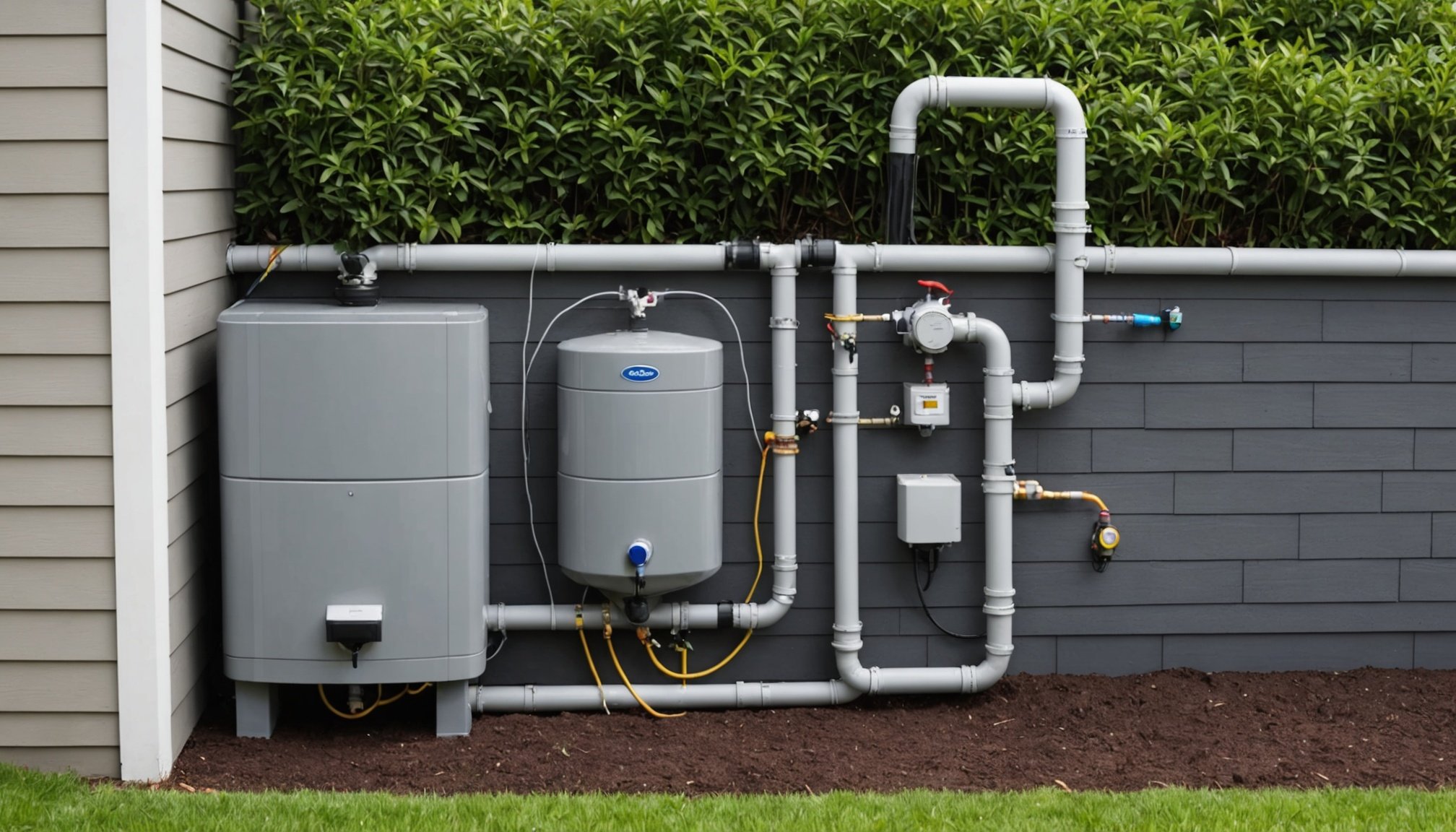Overview of Gray Water Systems
Gray water systems are innovative solutions designed to reuse water from domestic activities such as bathing, laundry, and dishwashing. These systems aim to take advantage of water that would otherwise be wasted, providing a more sustainable alternative to traditional water use.
Implementing a gray water system offers numerous benefits. For homeowners in Exeter, this means taking a significant step towards reducing water bills and decreasing dependence on the municipal water supply. These systems cleverly redirect water to areas like gardens or toilets, making efficient use of resources that are already available.
Sujet a lire : Top Techniques for Minimizing Noise Pollution in Your Birmingham City Center Apartment
In terms of environmental impact, gray water recycling substantially helps in conserving freshwater resources. By reusing water, less strain is put on natural freshwater reserves, which is vital as these reserves face increasing pressure due to climate change and population growth. Additionally, by ensuring that water is reused rather than going to waste, the carbon footprint of households can be reduced.
The advantages of gray water systems also include promoting healthier garden ecosystems by providing plants with nutrient-rich water. This contributes not only to plant health but also to a more flourishing environment overall, placing homeowners firmly in the role of environmentally responsible citizens.
A lire aussi : Navigating Asbestos Safely: A Guide for Renovating Older Homes in Hull
Local Regulations and Compliance in Exeter
Understanding Exeter’s local gray water regulations is crucial for anyone planning to implement a gray water system. The legal framework is designed to ensure safe and environmentally friendly use of gray water within the community. In general, Exeter’s regulations align with broader environmental goals while maintaining specific local standards.
When considering a gray water system, acquiring the necessary permits for gray water systems is a fundamental step. The process typically requires submitting detailed documentation, which includes system plans, safety measures, and proof of compliance with sanitation codes. This documentation ensures the system will operate efficiently without posing risks to public health or the environment.
Here are some compliance tips to consider:
- Research and understand the specific local requirements, as these can vary even within nearby municipalities.
- Engage with local authorities early in the planning phase to ensure all aspects of your system meet current legal standards.
- Consider consulting with a professional who has experience in navigating gray water regulations to streamline the permitting process.
By proactively addressing these areas, you can effectively manage your project while adhering to Exeter’s regulatory landscape.
Planning Your Gray Water System Installation
Embarking on the installation of a gray water system requires meticulous planning and thoughtful considerations of several factors to ensure optimal effectiveness. One crucial step is site assessment, which involves evaluating your property to determine suitable locations for the system’s components. Consider the landscape’s natural slope, soil type, and proximity to plants or gardens that can benefit from the water.
In the design phase, choose a system layout that aligns with your household’s specific requirements and spatial constraints. Design considerations might include whether a gravity-fed system suits your needs or if a pump-based design would be more appropriate due to the property’s topography. Additionally, ensure compliance with local regulations regarding gray water reuse, which may impose specific design or installation restrictions.
Plumbing and layout considerations are another vital aspect. Identify existing plumbing that can be integrated with the gray water system, such as laundry, shower, or sink drains. Plan for manual override options, ensuring that traditional wastewater drainage remains possible when necessary. Assess your property’s plumbing layout to minimise potential disruptions and costs during installation. Engage professionals if your system’s complexity exceeds basic DIY capabilities, as expert input can prevent costly mistakes and ensure a safe, efficient gray water solution for your home.
Step-by-Step Installation Guide
Installing a gray water system requires careful planning and the right approach. Begin your journey with the correct information about installation steps and the essential necessary tools for the task.
Preparing the Site
The first step in installing a gray water system involves thorough site preparation. It is essential to choose an appropriate location that complies with local regulations. Start by marking the area for excavation, considering the natural slope and drainage pathways which will facilitate water movement. Use appropriate tools like shovels or mini-excavators for precise work. Ensure the site is clear of debris and vegetation that could impede installation.
Installing the Collection System
Once the site is prepared, focus on installing the collection tanks and pipes. Fit the tank in the excavated area, ensuring it is level and stable to avoid any shifts that might disrupt the system. Carefully connect the pipes to the existing plumbing to divert wastewater into the collection tank. Make certain all joints are securely fastened and leak-proof to maintain system integrity.
Implementing the Distribution Mechanism
After securing the collection system, set up the distribution mechanism. This involves routing the collected gray water to your landscape or irrigation system. Use durable pipes for this phase and plan the layout to ensure even water distribution across the designated area which enhances resource efficiency and prevents overwatering.
Necessary Materials and Tools
To successfully set up a gray water system, it is crucial to have the right materials and tools on hand. The materials you will need include pipes, fittings, pumps, valves, and filtration units. These components ensure that the system functions efficiently and safely, channeling gray water from your home for other purposes like irrigation.
In terms of tools needed for installation, you will require pipe cutters, wrenches, screwdrivers, and possibly a drill, which are essential for assembling and securing the components of your system. These basic tools ensure that you can piece together the system according to your plan, without unexpected hurdles.
When it comes to cost estimation, the overall investment for the materials and tools can vary based on the size and complexity of your setup. Estimated costs for essential materials could range from £200 to £500, depending on your choice of components. Tools might add another £50 to £100 if you don’t already own them. Considering these expenses beforehand helps in preparing a realistic budget to effectively manage your resources.
Engaging with these tasks confidently and well-prepared will make the process smoother and more efficient.
Maintenance and Troubleshooting
Performing regular maintenance on your gray water system is crucial to ensure its effectiveness. Routine checks can prevent many common issues from escalating. Here are some basic practices: inspect filters frequently, clean them to prevent blockages, and check pipes for leaks or any signs of wear. It’s also vital to verify that the distribution system is functioning correctly to avoid water pooling, which could lead to unpleasant odours or damage to surrounding areas.
Common issues with gray water systems often originate from blockages or leaks. Blockages usually result from debris or residues that accumulate in the system. A simple solution is to regularly clean filters and strainers. Leaks may occur due to degradation of pipes over time, and replacing faulty components promptly is advised to maintain system integrity.
Be vigilant for signs indicating that the system needs attention. An unusual odour, reduced water flow, or visible water pooling can signal problems. Quick response is essential to mitigate further damage. Troubleshooting tips include regularly checking for clogs, ensuring the integrity of connections, and following manufacturer guidelines. Understanding these basics will help keep your gray water system running smoothly, extending its lifespan and efficiency.
Long-term Benefits and Considerations
When exploring sustainability in Exeter, it’s crucial to consider both the environmental and economic impacts of adopting eco-friendly practices. By utilising gray water systems, Exeter homeowners can experience significant long-term advantages.
Environmental Benefits
Gray water, often derived from baths, sinks, or washing machines, can be repurposed to irrigate gardens, thereby conserving fresh water. Such eco-friendly practices dramatically lower water demand, ultimately benefiting local ecosystems and reducing the strain on municipal water resources. This sustainable approach ensures preservation of vital water sources for future generations in Exeter.
Economic Benefits
From a financial perspective, implementing gray water systems may lead to substantial savings on water bills. By reducing water consumption, households in Exeter not only lower monthly expenses but may also increase property values, as sustainable homes increasingly attract eco-conscious buyers. Additionally, government incentives or rebates could offset initial installation costs.
Community and Social Benefits
Encouraging sustainable practices fosters a sense of community responsibility. It creates awareness around resource conservation, inspiring others in Exeter to prioritise environmental health. This proactive stance cultivates a greener, more resilient community, setting a benchmark for surrounding areas. Embracing sustainability isn’t just beneficial individually; it paves the way for a thriving, eco-friendly Exeter.











